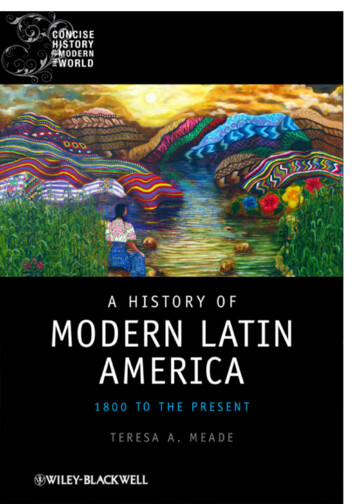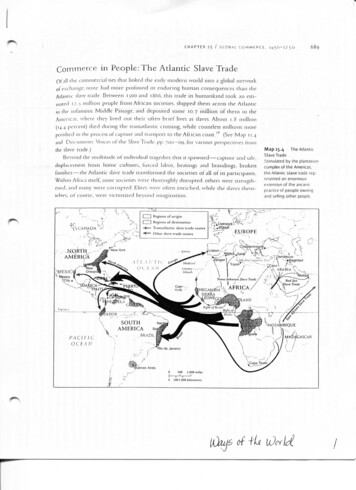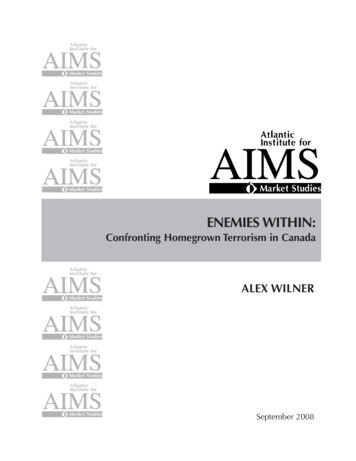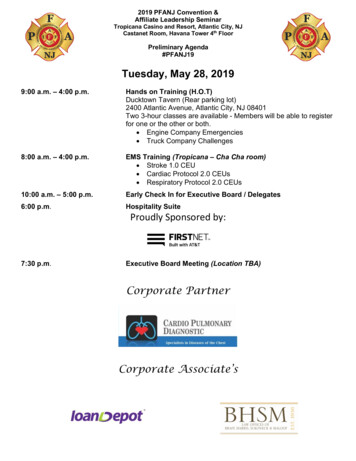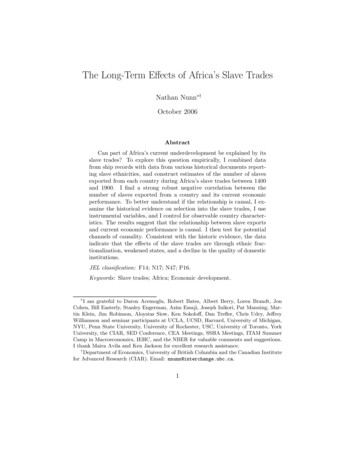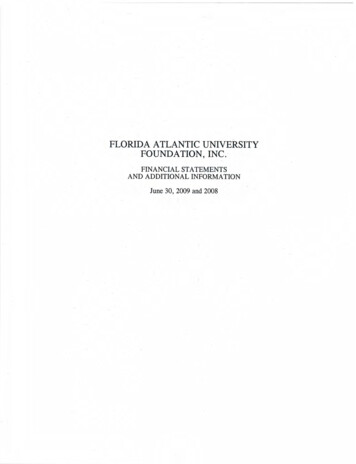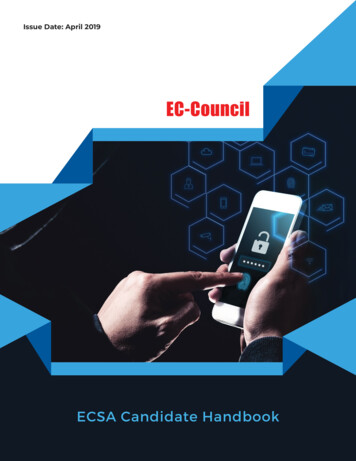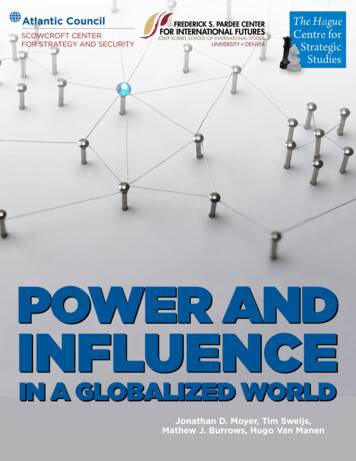
Transcription
POWER ANDINFLUENCEIN A GLOBALIZED WORLDJonathan D. Moyer, Tim Sweijs,Mathew J. Burrows, Hugo Van Manen
POWER ANDINFLUENCEIN A GLOBALIZED WORLDJonathan D. MoyerTim SweijsMathew J. BurrowsHugo Van ManenThe authors would like to thank Kumail Wasif for his significant contribution earlier in this project. Also, thanks toDrew Bowlsby, David Bohl, Barry Hughes, Whitney Doran, Mickey Rafa, John McPhee, Lisa Lane Filholm, TimothySmith, Douglas Peterson, and the large team of research assistants at the University of Denver who contributedto this report.This report is written and published in accordance with the Atlantic Council Policy on IntellectualIndependence. The authors are solely responsible for its analysis and recommendations. The AtlanticCouncil and its donors do not determine, nor do they necessarily endorse or advocate for, any of thisreport’s conclusions. 2018 The Atlantic Council of the United States. All rights reserved. No part of this publication may bereproduced or transmitted in any form or by any means without permission in writing from the AtlanticCouncil, except in the case of brief quotations in news articles, critical articles, or reviews. Please directinquiries to:Atlantic Council1030 15th Street NW, 12th FloorWashington, DC 20005ISBN-13: 978-1-61977-521-3January 2018
TABLE OF CONTENTS1Preface2Executive Summary4Introduction6Conceptualizing Influence8Measuring Influence: The FBIC Index11The Distribution of Global Influence: Trends and Patterns15The Countries That Punch Above and Below Their Weight17The Regional Reach of Influential States18Chinese and Russian Influence in NATO Member States19Africa is Rising along with Chinese Influence21Zones of Contestation: Pivot States23Networks of Influence26Insights and Implications
POWER AND INFLUENCE IN A GLOBALIZED WORLDPREFACEWe have known for many years that globalization is changing the meaning of power, butit has been difficult to define that shift, letalone quantify it. It is not just material capabilities—such as gross domestic product (GDP) or defense expenditures—that constitute a country’s power. Howwell a country is positioned to influence others througheconomic trade, military transfers, and membership inregional and global institutions is also an importantsource of power. This pathbreaking paper takes on thechallenge of showing us the way to measure influenceand how different countries’ influence has increasedor decreased since 1963. Formerly, analysts only hadrough measures as GDP or defense expenditures forgauging how much better or worse a country wasdoing relative to the rest of the international community. The Foreign Bilateral Influence Capacity (FBIC)Index, introduced by this paper, maps for the first timethe rise and fall of influence for key countries.No one is arguing that material capacities are not andwill not remain very important to a country’s power,particularly now that geopolitics has returned. Buthow well a country is positioned to influence anotheralso is a key factor. The twentieth century was theAmerican century, not just because the United Stateswas the victor in the two world wars but also becausemuch of the rest of the world was persuaded to adoptsuch traditional American values as capitalism anddemocracy.Worrisome are the findings for today’s United States.The United States still retains a lead in global influence,but its share has been decreasing and is considerablysmaller than its share of coercive capabilities. It willcome as no surprise that China has been the big winnerin the past decade, vastly expanding its influence asits economic power increases. But what is not alwaysappreciated is that China’s influence is no longerconcentrated in its region. China’s influence surpassedthe United States in Africa 2013, as measured by1234the FBIC Index. The United States and China are thetwo powers with the largest global reach in terms ofinfluence. But many European states punch above theirweight by comparison to the size of their economies.This is not the first time that I have partnered with theUniversity of Denver’s Pardee Center for InternationalFutures. While I was the counselor at the US NationalIntelligence Council (2003-2013) responsible forproducing three editions of the highly rated GlobalTrends report,1 the Pardee Center was critical for themodeling of those trends. More recently, after retiringand moving to the Atlantic Council, I partnered againwith the Pardee Center to produce three joint reportson cyber,2 demographic,3 and geopolitic risk4 sponsoredby Zurich Insurance. I am pleased that we could onceagain collaborate on such a thought-provoking way ofanalyzing power in the twenty-first century. I am alsopleased to team up with the The Hague Centre forStrategic Studies, which I know from their importantrole in futures work on the other side of the Atlantic.The collaboration between our three institutions, I daresay, showcases once again the added value that strongtransatlantic partnerships can yield.Mathew J. BurrowsDirector, Foresight, Strategy, and Risks InitiativeScowcroft Center for Strategy and SecurityThe last of three reports we worked on together was: “Global Trends 2030: Alternative Worlds” National Intelligence Council, November2012, https://www.dni.gov/files/documents/GlobalTrends 2030.pdf.“Risk Nexus: Overcome by cyber risks? Economic benefits and costs of alternate cyber futures,” Atlantic Council and Frederick L.Pardee Center for International Futures, September 2015, /.Mathew J. Burrows, “Reducing the Risks from Rapid Demographic Change,” Atlantic Council, September 2016, .“Our World Transformed: Geopolitical Shocks and Risks,” Atlantic Council and Frederick L. Pardee Center for International Futures,April 24, 2017, report.ATLANTIC COUNCIL1
POWER AND INFLUENCE IN A GLOBALIZED WORLDEXECUTIVE SUMMARYToday the ability to get other states to act in theinternational system may be characterized moreby formal networks of influence than by traditional measures of coercive material capabilities. Yet,the concept of coercive power, rather than influence,continues to be central both in scholarly and politicaldiscourses about international order and the ability ofnation states to promote and protect critical nationalinterests. The lack of a clear but also measurable concept of what influence is and what tangible benefitsaccrue from it may be partly to blame for this.In filling that void, this report presents the highlightsof our analysis of the newly compiled Formal BilateralInfluence Capacity (FBIC) Index. The FBIC Indexcontains bilateral measures of the formal economic,political, and security influence capacity of statesworldwide from 1963 to 2016. Our analysis maps thechanging dynamics of state influence over time. Keyfindings from this report include the following: Global influence is concentrated in the hands of thefew. Only ten countries possess about half of theworld’s influence. Similar to trends in the global distribution ofpower, global influence has been dispersing. Agrowing number of states wield greater amountsof influence over larger geographical distances. The United States still retains a global lead interms of its share of global influence capacity, butits share has been decreasing and is considerablysmaller than its share of the world’s coercivecapabilities. China’s upward trajectory has been impressive. Ithas vastly expanded its influence, not only in itsown region but also outside of it, including in NATOmember states and in Africa at large, where it hassurpassed the United States. Russia’s trajectory has been similarly sizeable, butin the opposite direction: it has lost considerableamounts of influence, including in countries in theformer Soviet space. European states, including some small onessuch as the Netherlands, significantly punch2above their weight in comparison to the size oftheir economies. Great powers continue to vie over spheres ofinfluence for a variety of military-strategic,economic, and ideological reasons. Pivot states arelocated in the Middle East, Central Asia, SoutheastAsia, Latin America, and West Africa. The past two decades saw the emergence of newnetworks of influence and the reconfiguration ofothers around dominant hubs including in theMiddle East and China.Table 1 shows the top ten countries in 2016 for threemeasures of power and influence. The Foreign BilateralInfluence Capacity (FBIC) Index is introduced in thisreport and measures multidimensional relationalinfluence bilaterally. The Global Power Index (GPI)(featured in recent Global Trends reports producedby the National Intelligence Community) measuresmultidimensional institutional, economic, material,and technological military capabilities nationally. GrossDomestic Product (GDP) at Market Exchange Ratesis the sum of all final goods and services produceddomestically and is often used as a proxy for nationalcapabilities.ATLANTIC COUNCIL
POWER AND INFLUENCE IN A GLOBALIZED WORLDTable 1: Top 10 countries for three measures of influence—FBIC Index, GPI, GDP, 2016Foreign BilateralGlobal PowerGross DomesticInfluence Capacity (FBIC) IndexIndex (GPI)Product (GDP)RankCountryGlobal Share(%)CountryGlobal Share(%)CountryGlobal Share (%)20161United States11.2%United States23.6%United 2%Canada2.4%ATLANTIC COUNCIL3
POWER AND INFLUENCE IN A GLOBALIZED WORLDINTRODUCTIONPolicymakers, pundits, and scholars (with the exception, perhaps, of a few hard-core realists),widely acknowledge that power and influenceare derived from more than just coercive military capabilities, but are exercised through networks of economic, political, and security interactions involvingstates as well as non-state actors. Influential states areable to effectively deploy a broader portfolio of instruments-of-influence to modify the beliefs and/or the behavior of other states. It is this ability that lies at theheart of effective statecraft—one that protects and promotes national interests—in today’s globalized world.Despite the growing importance of relational power, thebudgets of State Departments and Foreign Services ofcountries on both sides of the Atlantic have receivedsubstantial cuts these past few years. The TrumpAdministration’s budget for Fiscal Year 2018 includesplans to decrease the State Department’s budget by30 percent. Departments of key European countriessuch as France and the United Kingdom have alsobeen severely downsized in the aftermath of the GreatRecession.5 These cuts are not only about the needto ‘balance-the-budget,’ but take place in the contextof the wave of populist pro-sovereignty that hasswept the political landscape of Western democraciesin recent years. The concomitant societal backlashagainst globalization is further fueling political supportto ‘take back national control’ and withdraw frominternational participation, as was clearly captured byBrexit and Trump’s America First doctrine. Whether therise of this movement was caused by the ‘liberal order’being ‘rigged,’6 or resulted from the failure of politicalleaders to properly explain the benefits of internationalparticipation to their constituencies, is a question wewill not concern ourselves with here.756784Conspicuously absent in popular and scholarly debatesis an understanding of what international influenceis. Beyond anecdotal evidence or broad brusheddescriptions of the utility of ‘soft,’ ‘smart,’ or ‘civilian’power, there is simply neither a clear concept nor asystematic measurement of international influencederived from relational dependence.8 This lack of clearconceptualization drives a gap in measurement.In this report, we seek to fill some of this conceptualand empirical gap. We present a set of highlights fromthe results of an in-depth analysis of a newly createddataset called the Foreign Bilateral Influence Capacity(FBIC) Index that measures the bilateral influence ofstates. The FBIC Index includes forty-two economic,political, and security indicators with over 200 millionindividual observations from 1963 to the present. Themultidimensional, dyadic measurement of influencemakes it possible to conduct a broader analysisof different aspects of international relations thantraditional power, resource-based approaches.Using the FBIC Index, we identify the key influencersin the international system and analyze the states thatpunch above their weight and those that punch below.We trace the rise of China, the long trajectory of declineof some European states, as well as the surprisinglystrong performance of others, and we reflect on thevery different positions of the United States andRussia in all of this. We expose regional spheres ofinfluence and pay attention to the contested zonesin the international system and the pivot states thatreside there. Finally, we look at networks of influencein the international system and discuss their evolutionover time.For Trump’s Proposal, see “A New Foundation for American Greatness: Fiscal Year 2018,” Office of Management and Budget, les/omb/budget/fy2018/budget.pdf; see also “The Key Spending Cuts and Increasesin Trump’s Budget,” New York Times, May 22, 2017, mp-budget-winners-losers.html?mcubz 3& r 0; for Great Britain, see John McDermott, “UK Foreign Office ministers warn over cuts,” Financial Times, November2, 2015, -ed1a37d1e096; for France, see Tony Cross, “France to face extra budgetcuts to meet EU deficit target,” RFI, July 11, 2017, a-budget-cuts-meet-eu-deficittarget. Germany, on the other hand, increased its spending; see Nils Zimmermann, “German federal budget goes up for 2017,” DeutscheWelle, November 25, 2016, -for-2017/a-36528845.Jeff D. Colgan and Robert O. Keohane, “The Liberal Order Is Rigged,” Foreign Affairs, April 17, 2017, -04-17/liberal-order-rigged.For an excellent overview of various explanations, see Ronald Inglehart and Norris, Pippa, “Trump, Brexit, and the Rise of Populism:Economic Have-Nots and Cultural Backlash,” HKS Working Paper No. RWP16-026, July 29, 2016, http://dx.doi.org/10.2139/ssrn.2818659.See for example Joseph S. Nye Jr., “Get Smart: Combining Hard and Soft Power,” Foreign Affairs, July 1, 2009, /get-smart; Hillary Rodham Clinton, “Leading Through Civilian Power,” Foreign Affairs, November1, 2010, NTIC COUNCIL
POWER AND INFLUENCE IN A GLOBALIZED WORLDWith this report, we aspire to do more than just infuseforeign policy debates about the United States’ andEurope’s standing in the world with much neededconceptual and empirical clarity. We seek to bridgethat gap between quantitative policy analysis and realworld policymaking, and we outline, if only preliminarily,what we consider quintessential elements of a grandstrategy aimed at enlarging influence to protect andpromote critical national security interests.ATLANTIC COUNCILThis report is structured as follows: it first defines theconcept of influence in the FBIC Index with referenceto the literature on power and influence and explainsthe methodological fundamentals of the Index’sconstruction. (The thirty-page annex to this reportoffers more detail.) It then turns to the empiricalanalysis along the lines just described, and it concludeswith an assessment of the implications of our findings.5
POWER AND INFLUENCE IN A GLOBALIZED WORLDCONCEPTUALIZING INFLUENCEThe concepts of influence and power both featureprominently in international relations literature,9but extant scholarship often fails to coherentlydistinguish them from one another.10 We conceptualizeinfluence as a broader concept than power in international relations. The following section outlines ourconceptual framing for the concept of influence in theinternational system.In introducing our concept of influence, it is useful todistinguish and briefly discuss three schools of thought.The first views influence and power as synonymous andposits that the two concepts are indistinguishable.11This perspective, originally spearheaded by Max Weber,views power and influence alike as objects exercisedover “other persons”12—these are “the ability of anindividual or group to achieve their own goals or aimswhen others are trying to prevent them from realizingthem.”13 Prominent power theorists such as Robert A.Dahl, Steven Lukes, and David A. Baldwin have takenup this view, arguing that the concepts of influence andpower simply refer to actor A’s capacity to get actor Bto “do something that B would not otherwise do,”14 andthat the concepts of influence and power can be A second school of thought aligns with the first inits conceptualization of influence as a change whichactor A brings about in actor B. However it differs inits view that power—far from being synonymous withinfluence—is a concept that denotes actor A’s abilityto influence actor B.16 In this view, power is somethingwhich can be possessed while influence is somethingthat can be exerted. Realist authors such as HansMorgenthau and Kenneth N. Waltz hold this view andposit that a nation’s material capabilities play a keyrole in the state’s ability to modify the behavior ofits peers.17Finally, a third school of thought, which is adhered toby the FBIC Index, conceptualizes influence as a forcethat transforms into power when actor A actively(and successfully) utilizes it to modify the behavior ofactor B. It posits that the relationship between powerand influence is best captured as a hierarchy in whichinfluence is the general concept, and power is theconscious manifestation of influence.18 It subscribesto the notion that an actor can possess influenceby presiding over sources (whether natural, military,or relational), but contends that it does not holdpower unless it has the capacity to successfully fieldits sources of influence towards achieving desiredoutcomes.19 This sentiment is clearly expressed bySearching JSTOR according to the ‘power’ and ‘influence’ parameters yields 160,980 and 165,418 results respectively.See Ruth Zimmerling, Influence and Power: Variations on a Messy Theme (Dordrecht: Springer, 2005), 104–47; see also Ingmar Pörn,The Logic of Power (Oxford: Basil Blackwell, 1970), 68; Harold D. Lasswell and Abraham Kaplan, Power and Society: A Framework forPolitical Inquiry (New Haven: Yale University, 1950), 71; Serge Moscovici, “Sozialer Wandel Durch Minoritäten,” in Social Influence andSocial Change, trans. A. Hechler (London: Academic Press, 1979), 77; and Joseph Raz, Practical Reason and Norms, 2nd ed. (Princeton:Princeton University Press, 1975), 99.See Allen Baldwin, Economic Statecraft (New Jersey: Princeton University Press, 1985), 489; see also Joseph S. Nye Jr., The Future ofPower (New York: PublicAffairs, 2011), 12.Max Weber, The Theory of Social and Economic Organization (New York: The Free Press, 1947), 152.Weber, Theory, 152.See Robert A. Dahl, The Concept of Power (New York: Bobbs-Merrill, 1957), 202–3; see also Steven Lukes, Power: A Radical View (NewYork: Palgrave Macmillan, 2005), 36. Note that Lukes takes a mixed view on influence and power, and occasionally divorces the termsfrom one another entirely.David A. Baldwin, “Interdependence and Power: A Conceptual Analysis,” International Organization 34, no. 4 (1980): 502.See Dorwin Cartwright, “Influence, Leadership, Control,” in Handbook of Organizations, ed. James G. March (New York: Routledge,1965), 125; see also C. W. Cassinelli, Free Activities and Interpersonal Relations (The Hague: Martinus Nijhoff, 1966), 47–48; John R.P. French and Bertran Raven, “The Bases of Social Power,” in Studies in Social Power, ed. Dorwin Cartwright (Michigan: University ofMichigan Press, 1960), 609; John R. P. French, “A Formal Theory of Social Power,” Psychological Review 63 (1956): 728; Robert W. Coxand Harold Karan Jacobson, The Anatomy of Influence: Decision Making in International Organization (New York: Yale University Press,1973), 3; and Lukes, Power, 205.See Kenneth N. Waltz, Theory of International Politics (London: Addison-Wesley, 1979), 102–11; Hans Morgenthau, Politics amongNations: The Struggle for Power and Peace, 3rd ed. (New York: Alfred A. Knopf, 1948), 15.See Zimmerling, Influence and Power, 104.; see also Dennis H. Wrong, Power: Its Forms, Bases, and Uses (Oxford: Basil Blackwell, 1988),21; and Lasswell and Kaplan, Power and Society, 76–77, 84.Zimmerling, Influence and Power, 146.ATLANTIC COUNCIL
POWER AND INFLUENCE IN A GLOBALIZED WORLDDennis H. Wrong, who states that if actor A succeedsin altering actor B’s behavior “in the desired direction,then he clearly has power over B.”20The exercise of influence results from an unspokenunderstanding (or promise) that state A can cut offstate B if it fails to comply. Implicit influence mayalso manifest itself through co-optive means. In thesecases, it derives from state attractiveness. Stateattractiveness is understood as a source of co-optiveinfluence which compels third parties to go along withone another’s purposes “without any explicit threat orexchange taking place.” Because state B’s perceptionof state A’s “attractiveness” is dependent on a host ofstate-specific variables (e.g., its history with state A,culture of state B, etc.), it can be argued that ideationalpower—like its resource-based counterpart—alsoremains subject to relational context.Because of the array of potential types of influenceand its context specificity, the concept of influence isbest expressed in terms of state A’s potential capacityto influence state B rather than through the analysisof actual outcomes. This is because state influence—though it may be exerted intentionally—can also lead tochange that is “neither actively pursued nor beneficialto” the influencer,21 and partially because influence doesnot produce outputs which can be easily measured (orattributed) to actors at the dyadic level.The FBIC Index facilitates a multidimensionalunderstanding of influence in which both access tonational resources and relational context are treated.22This approach differs from other methods that rely on aresource-based model for measuring capacity to bringabout change in other actors.23 The multidimensionalapproach posits that state influence derives partiallyfrom discrepancies in access to national resources24and partially from relationally contextual factors,which, when combined, denote how effectively eitherside can leverage the national resources at its disposalto influence the other.25In the context of interstate relations, we submitthat influence derives from a combination of stateaccess to national resources, and from relational,context-specific dynamics between countries A andB, including state attractiveness. National resourcesinclude economic, political, and security means. Withina dyad, asymmetrical access to these resources causesimbalances in dependency. Such imbalances allow stateA to exert influence over state B both explicitly andimplicitly. In cases where imbalances lead to influencebeing exerted explicitly, state A’s relative independenceallows it to coerce state B because state A can crediblythreaten to withhold from state B resources on whichit depends. The implicit exercise of influence derivesfrom the same dynamic, but results from an unspokenunderstanding (or promise) that state A can cut offstate B if it fails to comply with unspoken wishes.20 Wrong, Power, 13.21 Wrong, 4, 23.22 David A. Baldwin, “Power and International Relations,” in Handbook of International Relations, 2nd ed. (London: SAGE Publications,2011), 275.23 John J. Mearsheimer, The Tragedy of Great Power Politics (New York: W. W. Norton & Company, 2001), Chapter 8; Waltz, Theory ofInternational Politics, 102–11; Morgenthau, Politics among Nations: The Struggle for Power and Peace, 15.24 See Baldwin, “Power and International Relations,” 275.25 See Zimmerling, Influence and Power, 123; see also Nye, The Future of Power, 13; Harold Dwight Lasswell and Abraham Kaplan, Powerand Society: A Framework for Political Inquiry (Yale University Press, 1965), 83; Andrew Heywood, Key Concepts in Politics (New York:Macmillan, 2000), 35; G Kuypers, Grondbegrippen van politiek (Utrecht; Antwerpen: Het Spectrum, 1973), 84, 87; Dahl, The Concept ofPower, 202-3; and Matteo Pallaver, “Power and Its Forms: Hard, Soft, Smart,” (thesis, London School of Economics and Political Science,2011), 12, http://etheses.lse.ac.uk/220/1/Pallaver Power and Its Forms.pdf.ATLANTIC COUNCIL7
POWER AND INFLUENCE IN A GLOBALIZED WORLDMEASURING INFLUENCE:THE FBIC INDEXThe Foreign Bilateral Influence Capacity (FBIC)Index is built upon the idea that two main factors affect the ability of states to exert influencein the international system. First, the extent of interaction across economic, political, and security dimensions creates opportunities for states to influence eachother. Second, the relative dependence of one state onanother for crucial aspects of economic prosperity orsecurity creates opportunities for the more dominantstate to cause the more dependent state to make decisions that they would not have otherwise made. We callthese two sub-indices Bandwidth and Dependence.26indicators to measure the reliance one country in thedyad has on the other.The contrast between Bandwidth and Dependence isexpanded upon in Table 3.Table 2: Data sources used in the FBIC IndexDescriptionBandwidthThe size of the relationship (“pipelinevolume”) between countries A andB based on economic, military, andpolitical indicators.DependenceThe relational context that governswhich side of the dyad can leverageobserved bandwidth to its advantagemore credibly.BANDWIDTH AND DEPENDENCEThe Bandwidth sub-index measures the extent of theconnection between two countries reflected in thevolume of shared economic, political, and securityinteractions. All components of the Bandwidth subindex are shared, absolute measures that represent thesize and number of connection points between twostates. One way of thinking about this is as the “sizeof the pipeline” of potential influence through whicha country can then direct actual influence towardsanother country. As the size of cross-border flowsincreases, so does the size of the pipeline that bothstates can use to potentially direct influence. The valueof the Bandwidth sub-index is symmetrical, so in eachyear the value from country A to country B will alwaysequal country B to country A. For example, total tradebetween countries A and B is one of our bandwidthindicators. For this sub-indicator the value for a givendyad in a given year will be the same whether a givenstate is considered country A or country B (this isnot true for the next sub-indicator). See Table 2 for adescription of the data sources used in the FBIC Index.The Dependence sub-index measures the “strength ofthe flow in each direction” or the degree to which an‘influencee’ relies on an influencer for crucial economicand security assets. We have not included any politicalindicators in the Dependence sub-index because ourdata does not include asymmetric political connections.The Dependence sub-index operationalizes relativeThis sub-index has two components: 1) the importanceof a flow relative to that total inflow for a country and2) the importance of a flow relative to the aggregateeconomic or military capacity of the country. Let usexplain that by going back to the trade example. Thefirst component of the Dependence sub-index is theshare of the overall trade volume of country B thatoccurs with country A. This is an important element ofinfluence: if most of country A’s external trade is withcountry B, it is quite dependent on it in as far as itstrade is concerned. But that indicator alone does nottell the full story. If trade represents only a very smallpart of country A’s GDP, then even a very high relativetrade dependence (in percent of trade terms) wouldyield less influence capacity than if its economy werehighly integrated in the global trading network.This is why measures of economy and military size areincluded in our dependence scores. For the economiccomponents of our Dependence measure, we utilizegross domestic product; for the security componentswe use military spending. The sub-index Dependenceis directed, or asymmetric, so the value of country Ato country B is different than the value from country Bto country A.26 For more information on the methodology used to construct the FBIC, please see pardee.du.edu/working-papers.8ATLANTIC COUNCIL
POWER AND INFLUENCE IN A GLOBALIZED WORLDTable 3: FBIC Index taxonomy and l tradeTotal arms transfersLevel of representationTrade agreementsMilitary alliancesIntergovernmental membershipTrade, % of total tradeArms imports, % of total armsimportsTrade, % of GDPArms imports, % of militaryspendingBandwidthDependenceAid, % of total aidAid, % of GDPThe FBIC Index is calculated by taking the productof the Bandwidth and Dependence sub-indices;a combination of the magnitude of shared ties and thedegree of dependency among the dyad.Each subcomponent in the FBIC Index is weighte
POWER AND INFLUENCE IN A GLOBALIZED WORLD 2 ATLANTIC COUNCIL T oday the ability to get other states to act in the international system may be characterized more by formal networks of influence than by tradi-tional measures of coercive material capabilities. Yet, the concept o
